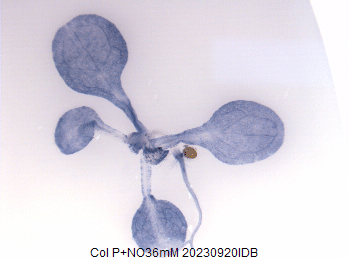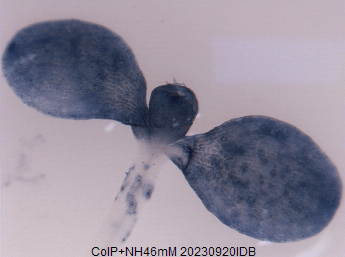A colorimetric method for the visual detection of intracellular phosphate distribution in plants has been developed by a Franco-Chinese collaboration involving a BIAM team. This method, called IOSA, highlights the uneven distribution of inorganic phosphate in cell tissues, opening up attractive prospects for the plant physiology sector.

Phosphate, a vital nutrient for plants, can be directly assimilated by plants thanks to its solubility in water. Nevertheless, it is present in very small quantities in soils, justifying the massive use of fertilizers by the agricultural sector. To optimize its use, scientists are seeking to better visualize its absorption and distribution in plant tissues.
As a result, the current range of tools1 does not offer to the scientists simple, effective methods for its detection. The main methods currently available involve biochemical assays, which involve grinding the samples and therefore do not preserve the tissue integrity. A biological fluorescent marker2 also exists, but requires the creation of transgenic lines. However, not all species can be transformed, and its use remains limited to the laboratory’s perimeter.
On the other hand, the use of radioactive isotopes (33P or 32P) in radio-imaging makes offers the possibility to study the movement of this ion within plants3 and 4, but do not distinguish inorganic from metabolized forms of phosphate.
This scientific collaboration, overcomes all these limitation, by developing a simple and effective colorimetric3 technique. Samples are bathed in solutions that specifically reveal the distribution zones of phosphate present in cells. IOSA thus offers a semi-quantitative cellular resolution of its distribution within the various organs, and enables comparison of the quantities present in different samples. This method revealed the non-homogeneous distribution of this ion in plants, shedding light for example on the importance of the cellular bases surrounding the conductive tissues of rice, essential structures for the distribution of plant nutrients.
IOSA has also been successfully used for the selection of mutants with altered phosphate distribution. Taken together, these results open up exciting prospects for improving knowledge in both plant nutrition and plant breeding.

1 https://doi.org/10.1093/pcp/pcv208 Performance and Limitations of Phosphate Quantification: Guidelines for Plant Biologists
2 https://doi.org/10.1104/pp.114.254003 Live Imaging of Inorganic Phosphate in Plants with Cellular and Subcellular Resolution
3 https://doi.org/10.1098/rstb.2011.0229 Development of real-time radioisotope imaging systems for plant nutrient uptake studies
4 https://doi.org/10.7554/eLife.14577 A novel role for the root cap in phosphate uptake and homeostasis
Franco-Chinese collaboration
State Key Laboratory of Efficient Utilization of Arid and Semi-arid Arable Land in Northern China/Key Laboratory of Plant Nutrition and Fertilizer, Ministry of Agriculture, Institute of Agricultural Resources and Regional Planning, Chinese Academy of Agricultural Sciences, Beijing 100081, China.
National Engineering Research Center of Tree Breeding and Ecological Restoration, College of Biological Sciences and Technology, Beijing Forestry University, Beijing 100083, P.R. China.
Aix Marseille Univ, CEA, CNRS, BIAM, UMR7265, EBMP (Environnement, Bioénergies, Microalgues et Plantes), F-13115 Saint-Paul lez Durance, France.
State Key Laboratory of Subtropical Silviculture, Zhejiang A&F University, Hangzhou 311300, China.
Authors
M. Guo , W. Ruan , R. Li , Lei Xu , S. Hani , Q. Zhang , P. David , L. Nussaume , J. Ren , B. Zheng, K Yi.
More info on the points mentioned
Nature plants: Visualizing plant intracellular inorganic orthophosphate distribution doi.org/10.1038/s41477-023-01612-9